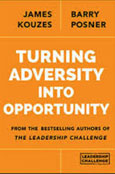July 2014: In This Issue
Welcome to the July issue of A New Leaf! With the passing of June, the length of each summer day is shortening. With the completion of the second quarter, your leadership ability to impact the full year results is also diminishing. This edition highlights the growing need of leaders to make an internal difference in light of an ever changing external environment.
“A Sense of Urgency” by John Kotter and “Turning Adversity into Opportunity” by James Kouzes/Barry Posner were both written acknowledging that “a world where the rate of change appears to be going up and up…has huge implications for the issue of urgency and performance”. Absent strategies and tactics designed specifically to address this rapid rate of change, leaders and their companies will fail.
Both books offer guidelines to address this important issue of continuous change. As you reflect upon the foregone opportunities from the prior six months, challenge yourself as to how you have been doing, as a leader, in creating a culture responsive to the dynamic external change. Kotter concludes his book with the assessment that “we all can do better”. What will your next step be? The future of your company depends on it.- Mike
 Book Review: “A Sense of Urgency” by John P. Kotter
Book Review: “A Sense of Urgency” by John P. Kotter
In his classic “Leading Change”, Kotter originally set forth the following eight step transformational process:
- Establishing a Sense of Urgency
- Forming a Powerful Guiding Coalition
- Creating a Vision
- Communicating the Vision
- Empowering Others to Act on the Vision
- Planning for and Creating Short Term Wins
- Consolidating Improvements
- Institutionalizing New Approaches
Based upon his research, over 70% of companies fail in total or in some major aspect of their change initiative. In many instances, these failures arise from a looming sense of organizational complacency reflected in the inability to establish and subsequently maintain the urgency necessary for success. How to counteract this high degree of complacency in light of the ever changing environment is the central theme in Kotter’s “A Sense of Urgency”.
The author notes in his preface that “urgency is becoming increasingly important because change is shifting from episodic to continuous. With continuous change, creating and sustaining a sufficient sense of urgency are always a necessity”
In addressing this necessity, true urgency is defined as being “driven by a deep determination to win, not anxiety about losing. With an attitude of true urgency, you try to accomplish something important each day, never leaving yourself with a heart attack producing the task of running one thousand miles in the last week of the race.”
Kotter then compares the behavior of true urgency with that of complacency. Behavior associated with a true urgency is “action that is:
- alert,
- fast moving,
- focused externally on the important issues,
- relentless, and
- continuously purging irrelevant activities to provide time for the important and to prevent burnout”
This is contrasted with complacency which is characterized by “unchanging activity” and “action that:
- ignores an organization’s new opportunities or hazards
- focuses inward and
- does whatever has been the norm in the past”
Kotter acknowledges that “a real sense of urgency” is much rarer that most people seem to think”. Thus the high rate of failure in organizational transformation.
Building on how to establish this key transformational imperative, Urgency sets forth the following four key tactics and steps necessary to address the need to “move, win and now” mentality:
- Bringing the Outside In
-Reconnect internal reality with external opportunities and hazards
-Bring in emotionally compelling data, people, video, sites and sounds
- Behaving with Urgency Every Day
-Never act content, anxious, or angry
-Demonstrate your own sense of urgency always in meetings, one on one interactions, memos, and email and do so as visibly as possible to as many people as possible
- Finding Opportunity with Crisis
-Always be alert to see if crisis can be a friend, not just a dreadful enemy, in order to destroy complacency
-Proceed with caution, and never be naïve, since crisis can be deadly
- Dealing with NoNo’s
-Remove or neutralize all the relentless urgency killers, people who are not skeptics but are determined to keep a group complacent or, if needed, to create destructive urgency
Specific actions for each tactic are provided in Urgency, complemented with real life examples of where the tactics have been successfully..and unsuccessfully… applied.
While all four tactics are critical to the success of organizational transformation, none is more visible than the leader “Behaving with Urgency Every Day”. Kotter discusses at length how leaders must model this behavior with includes:
- Purging and delegating
- Moving with speed
- Speaking with passion
- Matching words and deeds
- Let them all see it
As part of this important tactic, the concept of “urgent patience” is introduced and defined as “acting each day with a sense of urgency but having a realistic view of time. It means recognizing that (many) years may be needed to attain important and ambitious goals, and yet coming to work each day committed to finding every opportunity to make progress towards those goals.”
Kotter concludes that “sustaining urgency over time requires that it not only be created, and created well, but that it be re-created again and again”. “The basic pattern is simple: urgency leads to success leads to complacency”.
“At no time is complacency stronger than after people have worked very hard and have been rewarded by a visible, unambiguous win. A win can signal in people’s mind that any crisis is over and sacrifices are no longer necessary. After a big win, urgency can slide with remarkable speed into a new complacency. If urgency drops sufficiently and momentum is lost, pushing complacency away a second time can be much more difficult than it was the first (time). “
“The ultimate solution to the problem of urgency dropping after successes is to create the right culture”. This gets to the heart of leadership. How are you doing in both modeling the way and developing your culture to create the sense of urgency necessary to maintain and grow your market position and profitability? This book will help clarify your current status.
 Complementary Book Review: “Turning Adversity into Opportunity” by James Kouzes/Barry Posner
Complementary Book Review: “Turning Adversity into Opportunity” by James Kouzes/Barry Posner
Over a decade ago, Kouzes/Posner set forth in their best seller “The Leadership Challenge” the following “Five Practices of Exemplary Leadership”:
- Model the Way
- Inspire a Shared Vision
- Challenge the Process
- Enable Others to Act
- Encourage the Heart
As an update to this classic, the authors introduce “Turning Adversity into Opportunity” by clarifying that “the world is very different now, and you better get used to it. There is no turning back. In today’s reality, normal means turbulence…disruption … chaos … and that you can’t predict tomorrow’s winners based upon today’s successes. Challenge is the defining context for leadership.”
To address this dynamic environment, the authors identify and explore the following “Six Key Strategies”, building upon the “Five Exemplary Practices”, to successfully turn “adversity into opportunity”:
- Broaden the Context
- Defy the Verdict
- Fully Commit
- Take Charge of Change
- Engage Others
- Show you Care
“Adversity” explores each of these strategies in detail while identifying a number of vital questions that can help you and your constituents determine how to navigate effectively through these turbulent times.
The strategy of “taking charge of change” aligns closely with the authors’ exemplary practice of “modeling the way”. In introducing this strategy, the authors refer to prior research where they asked leaders which terms best described the character, feel, spirit and nature of their personal-best leadership experience. Over 95% of the cases used terms such as challenging, rewarding, exciting in addition to words signifying conviction (dedication, intensity, commitment) and passion (inspiring, motivating, energizing). “Challenging situations can actually motivate and engage people to do their best”, though the authors acknowledge that such situations can be filled with stressors arising from uncertainty.
What makes the difference between being a leader in these situations is “how you respond in the moment. Challenge is the motivating environment for excellence”.
The authors identify commitment, control and challenge as those attitudes necessary to successfully taking charge of change”. As leader, “you have to get involved, engaged and be curious. You cannot sink into powerlessness or passivity. You can’t play it safe. Easy comfort and security are not only unrealistic but also stultifying”.
It is a leader’s role to help their team take charge of change. It is critical for the leader to find ways for people to stretch themselves. Key discussions questions relating to this strategy include:
- What do we deeply want to happen?
- What decisions and actions do we control?
- How can we positively influence the outcome?
- If we are going to fall, how can we fall forward and achieve a sense of progress?
This chapter ends with the guidance that “taking charge of change is how you invent your future rather than simply letting it happen to you”. As leader, how much are you inventing your future? The additional chapters of Adversity provide you with questions and actions instrumental to re-inventing your team as you lead them from “adversity to opportunity”.
©2013 See Change Management. All Rights Reserved. Site credit


